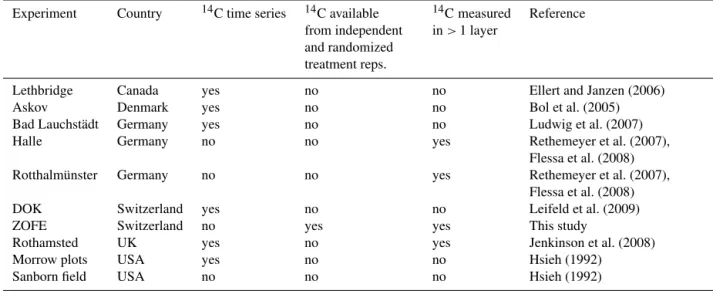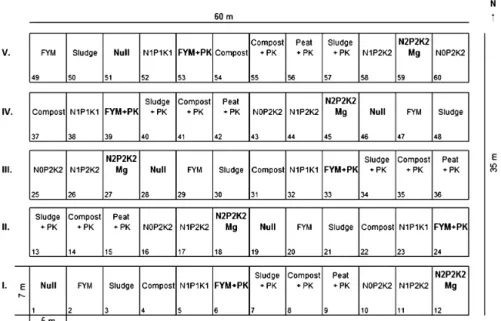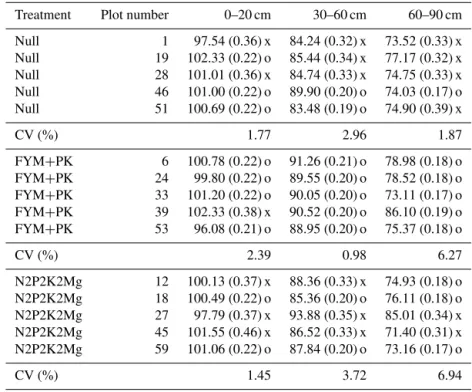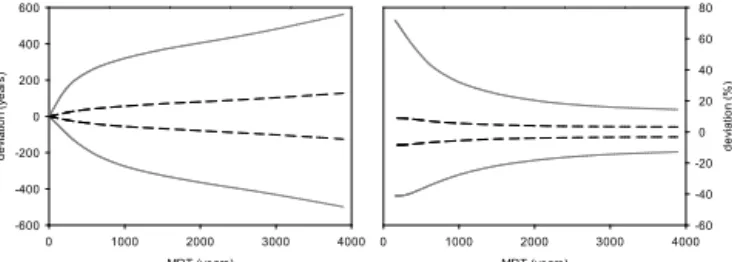www.soil-journal.net/1/537/2015/ doi:10.5194/soil-1-537-2015
© Author(s) 2015. CC Attribution 3.0 License.
SOIL
14
C in cropland soil of a long-term field trial –
experimental variability and implications for estimating
carbon turnover
J. Leifeld1and J. Mayer2
1Climate/Air Pollution Group, Institute for Sustainability Sciences, Agroscope, Reckenholzstrasse 191,
8046, Zurich, Switzerland
2Water Protection/Substance Flows Group, Institute for Sustainability Sciences, Agroscope,
Reckenholzstrasse 191, 8046, Zurich, Switzerland
Correspondence to:J. Leifeld (jens.leifeld@agroscope.admin.ch) and J. Mayer (jochen.mayer@agroscope.admin.ch)
Received: 20 February 2015 – Published in SOIL Discuss.: 5 March 2015 Revised: 30 June 2015 – Accepted: 8 July 2015 – Published: 28 July 2015
Abstract. Because of their controlled nature, the presence of independent replicates, and their known
man-agement history, long-term field experiments are key to the understanding of factors controlling soil carbon. Together with isotope measurements, they provide profound insight into soil carbon dynamics. For soil radiocar-bon, an important tracer for understanding these dynamics, experimental variability across replicates is usually not accounted for; hence, a relevant source of uncertainty for quantifying turnover rates is missing. Here, for the first time, radiocarbon measurements of five independent field replicates, and for different layers, of soil from the 66-year-old controlled field experiment ZOFE in Zurich, Switzerland, are used to address this issue.14C variability was the same across three different treatments and for three different soil layers between the surface and 90 cm depths. On average, experimental variability in14C content was 12 times the analytical error but still, on a relative basis, smaller than variability in soil carbon concentration. Despite a relative homogeneous variabil-ity across the field and along the soil profile, the curved nature of the relationship between radiocarbon content and modelled carbon mean residence time implies that the absolute error of calculated soil carbon turnover time increases with soil depth. In our field experiment findings on topsoil carbon turnover variability would, if applied to subsoil, tend to underweight turnover variability even if experimental variability in the subsoil isotope con-centration is the same. Together, experimental variability in radiocarbon is an important component in an overall uncertainty assessment of soil carbon turnover.
1 Introduction
Long-term agricultural field trials have long been recognized as important sources for understanding long-term manage-ment effects on soil parameters such as soil organic carbon content and turnover (Jenkinson, 1991). Their special value lies in their controlled nature, the long-term record of man-agement activities, reliable soil and crop parameter records as well as site climate data. Many experiments have indicated that soil carbon responds sensitively to agricultural manage-ment and have allowed for sustainable managemanage-ment
prac-tices to be identified. Hence, these data sets are also valu-able sources of information for developing or testing soil and ecosystem carbon models (Smith et al., 1997; Franko et al., 2011).
538 J. Leifeld and J. Mayer:14C in cropland soil of a long-term field trial
Table 1.Long-term agricultural field experiments where radiocarbon was used to derive soil carbon turnover estimates.
Experiment Country 14C time series 14C available from independent and randomized treatment reps.
14C measured
in>1 layer
Reference
Lethbridge Canada yes no no Ellert and Janzen (2006)
Askov Denmark yes no no Bol et al. (2005)
Bad Lauchstädt Germany yes no no Ludwig et al. (2007)
Halle Germany no no yes Rethemeyer et al. (2007),
Flessa et al. (2008)
Rotthalmünster Germany no no yes Rethemeyer et al. (2007),
Flessa et al. (2008)
DOK Switzerland yes no no Leifeld et al. (2009)
ZOFE Switzerland no yes yes This study
Rothamsted UK yes no yes Jenkinson et al. (2008)
Morrow plots USA yes no no Hsieh (1992)
Sanborn field USA no no no Hsieh (1992)
the isotopic signature, i.e. the13C/12C or14C/12C ratio, of the input material to soil is not constant over time, it induces a directed shift in the soil’s isotopic signature. For a known shift in input signature, the subsequent change in the soil’s isotopic signature allows for the replacement rate of old by new carbon to be estimated. For example, changes from C3 to C4 vegetation or vice versa alter the13C/12C ratio of the input and allow for estimation of turnover rates (Balesdent et al., 1988). Besides stable 13C/12C, the radioactive iso-tope14C also has a long history of application in soil carbon studies (Harkness et al., 1986; Jenkinson et al., 1992; Trum-bore, 1993). The introduction of extra14C to the atmosphere via nuclear bomb testing in the 1950s and 1960s of the last century and the subsequent diffusion of that label into terres-trial ecosystems has triggered a vast amount of research that makes use of the 14C signature of soil carbon. The beauty of 14C is given by its ubiquity and its potential to cover the whole relevant time frame of soil carbon turnover, ranging from years to millennia.
Information from both controlled long-term field experi-ments and the soil’s14C signature has been combined pre-viously with the aim to get better insight into soil carbon dynamics (Table 1). These data are particularly useful for model development as the isotope reduces the degrees of freedom in the modelling approach – i.e. it constrains the carbon turnover dynamics and reduces the risk of giving right answers for the wrong reasons. For example, Jenkinson and Coleman (2008) used14C from the famous Rothamsted field trials to extend the existing Rothamsted Carbon Model (RothC) by means of a subsoil module. Hsieh (1993) took advantage of the oldest cropland experiments from the USA, Morrow plot and Sanborn field, to get insight into labile car-bon turnover. However, these and other applications as listed in Table 1 have not yet considered the variability of radio-carbon in the field. Experimental variability, both across the
field and within the soil profile, adds an important compo-nent of uncertainty to any modelling of terrestrial carbon. This variability needs to be known for reliable estimates of management–carbon storage feedbacks. For radiocarbon, the relatively high costs of the nowadays mostly used measure-ment by accelerator mass spectrometry (AMS) are a major obstacle to addressing experimental variability questions.
To our knowledge, experimental variability in soil14C us-ing independent treatment replicates has not yet been ad-dressed in any of the long-term cropland experiments listed in Table 1. Here, we aim to fill that gap by using recent
14C measurements of mineral soil from a 66-year temperate,
long-term cropland trial in Zurich, Switzerland. Two ques-tions are studied: (i) what is the variability in soil radiocarbon content in independent replicates of a long-term field trial both in top- and subsoil, and (ii) what are possible implica-tions of experimental variability for the interpretation of soil carbon turnover estimates?
2 Material and methods
The Zurich Organic Fertilization Experiment, ZOFE, was commenced in 1949 at the Swiss federal research institute for agriculture, Agroscope, in Zurich. It is located at 420 m a.s.l., receives an annual precipitation of 1040 mm, and has a mean annual temperature of 9◦C (1949–2009). The soil is a
well-drained, carbonate- and stone-free, homogeneous Haplic Lu-visol (IUSS Working Group WRB, 2006) (texture: clay 14 %, silt 27 %, sand 57 %). ZOFE comprises 12 different fertil-ization treatments with five replicates each (Fig. 1), applied to an 8-year crop rotation. The experiment is arranged in a systematic block design. A detailed experiment overview is provided by Oberholzer et al. (2014).
Treat-Figure 1.Spatial arrangement of the ZOFE field trial in Zurich indicating 12 treatments with five replicates each arranged in five blocks (I– V). Plot numbers in the lower left corner are listed together with measurements in Table 1. Treatments in bold (Null, FYM+PK, N2P2K2Mg) were used for the present study. For a detailed description of all treatments, please see Oberholzer et al. (2014).
ment “Null” has received no fertilizer since 1949, and treatment “FYM+PK” receives 2.5 t farmyard manure (dry organic matter) every second year plus annually 235 kg K and 35 kg P as mineral fertilizer. Treatment “N2P2K2Mg” received/receives 56/139 kg N (before/after 1981), 318/167 kg K (before/after 1991), 61/38 kg P (be-fore/after 1991), 12/6 kg Mg (be(be-fore/after 1991), and no or-ganic fertilizer. All mineral fertilizer units are in kg ha−1a−1. Differences in crop productivity resulted in different resid-ual plant carbon inputs of 556 (Null), 1085 (FYM+PK), and 1255 (N2P2K2Mg) (kg ha−1a−1) (Oberholzer et al., 2014).
Soil samples were taken in April 2012 from the centre of each plot using a powered rotating soil auger (Humax, Burch AG, Rothenburg, Switzerland) down to a depth of 90 cm. The auger is equipped with an outer shaft hosting a PVC in-let that gets filled with a volumetric soil sample of diameter 5.0 cm during drilling. Samples were pooled into segments of 0–20, 20–30, 30–60, and 60–90 cm. For the present study, samples from the plough pan at 20–30 cm were not analysed. After extraction, samples were sieved <2 mm and dried at 105◦C, roots were removed by hand, and an aliquot was finely ground. Prior to radiocarbon analysis, samples were pretreated using acid fumigation with 0.5 M HCl to remove possible remnants from liming or traces of pedogenic car-bonate. Soil radiocarbon content was measured by AMS at two different facilities: the radiocarbon laboratory of ETH Zurich and the radiocarbon laboratory of the University of Bern, Switzerland. Both systems operate following the pro-tocol of Synal et al. (2007). Radiocarbon concentrations are given as percent modern carbon (pMC) as defined by Stuiver and Polach (1977).
To study effects of experimental 14C variability on soil carbon dynamics, we applied a common, time-dependent steady-state soil carbon turnover model. This was first de-scribed by Harkness et al. (1986) and has since been used as single- or multiple-pool versions in various studies (e.g. Baisden et al., 2013; Gaudinski et al., 2000; Harrison, 1996; Trumbore et al., 1996). The model gives mean residence times (MRTs) of soil carbon. Because we have no14C time series available, the most simple version of that model is ap-plied representing a single-pool assumption as described in Leifeld et al. (2013). Although soil carbon time series are better described by multiple-pool approaches (Baisden et al., 2013), the assumption followed here is sufficient to discuss possible consequences of experimental variability for the in-terpretation of soil carbon dynamics. Because our data rep-resent a single point in time, they do not allow adequate pa-rameterization of a more complex model. Hence, we do not claim that the presented turnover estimates represent the in situ situation most realistically but rather that they allow dis-cussion of variability effects.
The effect of depth on pMC and carbon mean residence time was tested by univariate ANOVA separately for each treatment and for the aggregated sample across treatments.
3 Results and discussion
540 J. Leifeld and J. Mayer:14C in cropland soil of a long-term field trial
Table 2.Percent modern carbon (%) (±1σ uncertainty∗) of organic carbon in soil samples from the ZOFE trial taken in 2012 for three treatments and three soil layers. “CV” lines indicate the coefficient of variation for each treatment–depth combination. Plot number according to Fig. 1. “x” refers to lab ETH and “o” refers to lab Bern.
Treatment Plot number 0–20 cm 30–60 cm 60–90 cm
Null 1 97.54 (0.36) x 84.24 (0.32) x 73.52 (0.33) x Null 19 102.33 (0.22) o 85.44 (0.34) x 77.17 (0.32) x Null 28 101.01 (0.36) x 84.74 (0.33) x 74.75 (0.33) x Null 46 101.00 (0.22) o 89.90 (0.20) o 74.03 (0.17) o Null 51 100.69 (0.22) o 83.48 (0.19) o 74.90 (0.39) x
CV (%) 1.77 2.96 1.87
FYM+PK 6 100.78 (0.22) o 91.26 (0.21) o 78.98 (0.18) o FYM+PK 24 99.80 (0.22) o 89.55 (0.20) o 78.52 (0.18) o FYM+PK 33 101.20 (0.22) o 90.05 (0.20) o 73.11 (0.17) o FYM+PK 39 102.33 (0.38) x 90.52 (0.20) o 86.10 (0.19) o FYM+PK 53 96.08 (0.21) o 88.95 (0.20) o 75.37 (0.18) o
CV (%) 2.39 0.98 6.27
N2P2K2Mg 12 100.13 (0.37) x 88.36 (0.33) x 74.93 (0.18) o N2P2K2Mg 18 100.49 (0.22) o 85.36 (0.20) o 76.11 (0.18) o N2P2K2Mg 27 97.79 (0.37) x 93.88 (0.35) x 85.01 (0.34) x N2P2K2Mg 45 101.55 (0.46) x 86.52 (0.33) x 71.40 (0.31) x N2P2K2Mg 59 101.06 (0.22) o 87.84 (0.20) o 73.16 (0.17) o
CV (%) 1.45 3.72 6.94
* 1σis standard deviation
pMC
70 75 80 85 90 95 100 105
M
R
T
(y
e
a
rs
)
500 1500 2500 3500 4500
Figure 2. Relationship between percent modern carbon (pMC) and calculated carbon mean residence time (MRT) using a time-dependent steady-state single-pool turnover model. The inner line refers to mean values, the dashed band to the 95 % uncertainty range related to the average14C analytical error, and the outer, solid band to the 95 % uncertainty range related to the average experimental
14C variability in the field.
soil depth are indicative for longer carbon mean residence times in the deeper layer of soil and have been reported fre-quently for soils that were not prone to substantial inputs from fossil carbon (Budge et al., 2011; Gaudinski et al., 2000; Jenkinson et al., 2008; Toyota et al., 2010).
Table 2 also indicates that the coefficient of variation (CV) of pMC for five independent plots, representing mostly ex-perimental variability, lies between 1 and 7 % (mean over nine treatment–layer combinations: 3.15 %). This is, for the present data set, 3–23 times the CV of 0.3 % pMC of the ana-lytical precision of the AMS measurement. Notably, the CV for soil organic carbon concentration is, per treatment and layer, on average 9.5 % (data not shown) and thus 3 times that of the radiocarbon content. There was no significant depth effect on the coefficient of variation (p=0.16); hence,14C variability neither increases nor decreases with depth. At the same time, the CV grouped by treatment was not statistically different between “Null”, “FYM+PK”, and “N2P2K2Mg” (p=0.64). The latter implies that experimental14C variabil-ity as measured in ZOFE is related to site- or soil-inherent properties rather than to agricultural management.
MRT (years)
0 1000 2000 3000 4000
dev ia ti on ( % ) -60 -40 -20 0 20 40 60 80 MRT (years)
0 1000 2000 3000 4000
dev ia ti on ( y ea rs ) -600 -400 -200 0 200 400 600
Figure 3.Comparison of absolute (left) and relative (right) devi-ation of calculated MRTs from the mean, expressed as 95 % con-fidence interval of (i) average analytical errors (inner, dashed line) and (ii) average experimental variability in the field (outer, solid lines). In the ZOFE trial, MRTs of below 200 years resemble top-soil 0–20 cm, those of ca. 1200 years resemble 30–60 cm, and those of ca. 2600 years resemble 60–90 cm.
influenced pMC variability in the field. Owing to the com-bination of (i) a non-constant atmospheric radiocarbon con-centration as a result from long-term and short-term 14CO2
fluctuations and (ii) exponential radioactive decay in the soil, the relationship between pMC and MRT is non-linear. This is illustrated for a series of homogeneous soil pools of dif-ferent age. Radiocarbon signatures of such a pool series with range from 70 to 105 pMC (resembling the span found in the soil data, Table 2) correspond to MRTs of between 3891 and 156 years (Fig. 2). The pMC–age curve becomes steeper at smaller radiocarbon concentrations. Whereas the central curve in Fig. 2 gives results for the mean pMC, the inner and outer bands represent the 95 % CI of (i) the average variabil-ity owing to analytical error only (inner band) and (ii) the av-erage experimental variability in the soil. These bands give upper and lower probability limits for the calculated MRT, and the older the carbon is, the further they deviate from their mean. For example, a MRT of 3891 (CI 3392–4453) years is assigned to a soil carbon pool with signature pMC=70 (CI 67.50–72.50 pMC), whereas the same relative uncertainty for a mean pMC of 105 (Cl 101.20–108.80 pMC) corresponds to a MRT of 156 (CI 92–268) years.
Figure 3 further illustrates the principle. Soil carbon from 60 to 90 cm, carrying a signature of, for example, 75 pMC, has a calculated MRT of 2947 years with deviations of+477 and−428 years, referring to the variability among five in-dependent field replicates. The uncertainty range is reduced to+193 and−129 years (mean MRT 321 years) for a pMC of 100, roughly representing the current topsoil. While the absolute uncertainty declines the younger the soil becomes, the relative uncertainty increases in the opposite direction (Fig. 3, right). Figure 3 also exemplifies the wider uncertainty band, over the calculated pMC range, when experimental variability and not only measurement error is accounted for. At pMC 70, the uncertainty range of MRTs considering ex-perimental variability is 4.2 times that of measurement error only. This factor increases to 6.5 at pMC 105, indicating that for younger soil carbon the omission of experimental
vari-ability introduces a larger relative uncertainty than for older soil carbon.
4 Conclusions
Soil radiocarbon dating from a long-term agricultural exper-iment indicates that experexper-imental variability of this param-eter is many times the analytical error. Experimental vari-ability seems not to be controlled by either management or soil depth. Conversion of relative uncertainty in radiocarbon content to relative uncertainty in carbon turnover reveals a higher sensitivity of carbon turnover to 14C variability in deeper soil layers that contain older carbon. Consequently, when soil samples from a long-term field trial are pooled per depth and treatment for14C analysis, the underestimation of the actual experimental variability of soil carbon turnover is larger for subsoil samples where long-lived C pools are more abundant.
Acknowledgements. We thank Irka Hajdas and Lukas Wacker, ETH, and Sönke Szidat, Oeschger Centre, University of Bern, for AMS measurements and the Swiss Federal Office for the Environment for financial support, contract L482-0519.
Edited by: B. Jansen
References
Baisden, W. T., Parfitt, R., Ross, C., Schipper, L., and Canessa, S.: Evaluating 50 years of time-series soil radiocarbon data: Towards routine calculation of robust c residence times, Biogeochemistry, 112, 129–137, 2013.
Balesdent, J., Wagner, G. H., and Mariotti, A.: Soil organic mat-ter turnover in long-mat-term field experiments as revealed by C-13 natural abundance, Soil Sci. Soc. Am. J., 52, 118–124, 1988. Bol, R., Eriksen, J., Smith, P., Garnett, M. H., Coleman, K., and
Christensen, B. T.: The natural abundance of C-13, N-15, S-34 and C-14 in archived (1923–2000) plant and soil samples from the askov long-term experiments on animal manure and mineral fertilizer, Rapid Comm. Mass Spectro., 19, 3216–3226, 2005. Budge, K., Leifeld, J., Hiltbrunner, E., and Fuhrer, J.: Alpine
grassland soils contain large proportion of labile carbon but indicate long turnover times, Biogeosciences, 8, 1911–1923, doi:10.5194/bg-8-1911-2011, 2011.
Ellert, B. H. and Janzen, H. H.: Long-term biogeochemical cycling in agroecosystems inferred from13C,14C and15N, J. Geochem. Exp., 88, 198–201, 2006.
Flessa, H., Amelung, W., Helfrich, M., Wiesenberg, G. L. B., Gleixner, G., Brodowski, S., Rethemeyer, J., Kramer, C., and Grootes, P. M.: Storage and stability of organic matter and fossil carbon in a luvisol and phaeozem with continuous maize crop-ping: A synthesis, J. Plant Nutr. Soil Sci., 171, 36–51, 2008. Franko, U., Kolbe, H., Thiel, E., and Liess, E.: Multi-site validation
542 J. Leifeld and J. Mayer:14C in cropland soil of a long-term field trial
Gaudinski, J. B., Trumbore, S. E., Davidson, E. A., and Zheng, S. H.: Soil carbon cycling in a temperate forest: Radiocarbon-based estimates of residence times, sequestration rates and partitioning of fluxes, Biogeochemistry, 51, 33–69, 2000.
Harkness, D. D., Harrison, A. F., and Bacon, P. J.: The temporal distribution of bomb c-14 in a forest soil, Radiocarbon, 28, 328– 337, 1986.
Harrison, K. G.: Using bulk soil radiocarbon measurements to esti-mate soil organic matter turnover times: Implications for atmo-spheric CO2levels, Radiocarbon, 38, 181–190, 1996.
Hsieh, Y. P.: Pool size and mean age of stable soil organic-carbon in cropland, Soil Sci. Soc. Am. J., 56, 460–464, 1992.
Hsieh, Y. P.: Radiocarbon signatures of turnover rates in active soil organic-carbon pools, Soil Sci. Soc. Am. J., 57, 1020–1022, 1993.
IUSS Working Group WRB: World Reference Base for Soil Re-sources 2006, World Soil ReRe-sources Reports 103, FAO, Rome, Italy, 2006.
Jenkinson, D. S.: The Rothamsted long-term experiments – are they still of use, Agronomy J., 83, 2–10, 1991.
Jenkinson, D. S. and Coleman, K.: The turnover of organic carbon in subsoils. Part 2. Modelling carbon turnover, Euro. J. Soil Sci., 59, 400–413, 2008.
Jenkinson, D. S., Harkness, D. D., Vance, E. D., Adams, D. E., and Harrison, A. F.: Calculating net primary production and annual input of organic-matter to soil from the amount and radiocarbon content of soil organic-matter, Soil Biol. Biochem., 24, 295–308, 1992.
Jenkinson, D. S., Poulton, P. R., and Bryant, C.: The turnover of organic carbon in subsoils. Part 1. Natural and bomb radiocarbon in soil profiles from the rothamsted long-term field experiments, Euro. J. Soil Sci., 59, 391–399, 2008.
Leifeld, J., Reiser, R., and Oberholzer, H. R.: Consequences of con-ventional versus organic farming on soil carbon: Results from a 27-year field experiment, Agronomy J., 101, 1204–1218, 2009.
Leifeld, J., Bassin, S., Conen, F., Hajdas, I., Egli, M., and Fuhrer, J.: Control of soil ph on turnover of belowground organic matter in subalpine grassland, Biogeochemistry, 112, 59–69, 2013. Ludwig, B., Schulz, E., Rethemeyer, J., Merbach, I., and Flessa, H.:
Predictive modelling of c dynamics in the long-term fertilization experiment at bad lauchstadt with the rothamsted carbon model, Euro. J. Soil Sci., 58, 1155–1163, 2007.
Oberholzer, H. R., Leifeld, J., and Mayer, J.: Changes in soil carbon and crop yield over 60 years in the zurich organic fertilization ex-periment, following land-use change from grassland to cropland, J. Plant Nutr. Soil Sci., 177, 696–704, 2014.
Rethemeyer, J., Grootes, P. M., Brodowski, S., and Ludwig, B.: Evaluation of soil C-14 data for estimating inert organic matter in the RothC model, Radiocarbon, 49, 1079–1091, 2007. Smith, P., Powlson, D. S., Glendining, M. J., and Smith, J. U.:
Us-ing long-term experiments to estimate the potential for carbon sequestration at the regional level: An examination of five Euro-pean scenarios, Agrokemia es Talajtan, 46, 25–38, 1997. Stuiver, M. and Polach, H. A.: Reporting of C-14 data – discussion,
Radiocarbon, 19, 355–363, 1977.
Synal, H.-A., Stocker, M., and Suter, M.: Micadas: A new compact radiocarbon ams system, Nuclear Instr. Meth. Phys. Res. Sect. B-Beam Interactions with Materials and Atoms, 259, 7–13, 2007. Toyota, A., Tayasu, I., Fujimaki, R., Kaneko, N., Uchida, M.,
Shi-bata, Y., and Hiura, T.: Effects of vegetation switch and sub-sequent change in soil invertebrate composition on soil carbon accumulation patterns, revealed by radiocarbon concentrations, Radiocarbon, 52, 1471–1486, 2010.
Trumbore, S. E.: Comparison of carbon dynamics in tropical and temperate soils using radiocarbon measurements, Global Bio-geochem. Cy., 7, 275–290, 1993.



